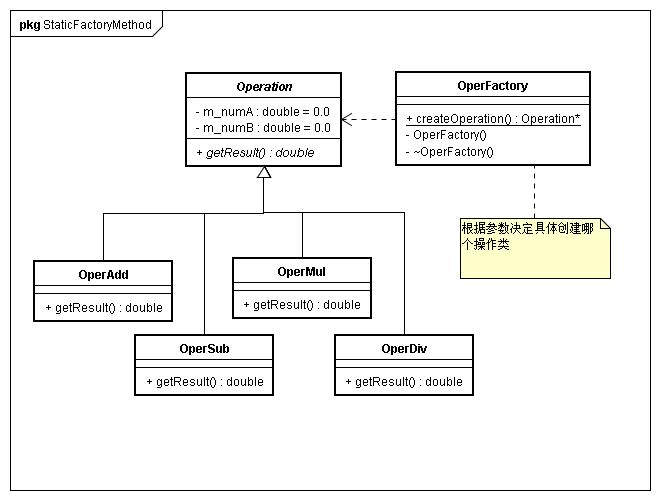简单工厂模式又被称为静态工厂模式。简单工厂模式是由一个工厂对象决定创建出哪一种产品类的实例。简单工厂模式是工厂模式家族中最简单实用的模式,可以理解为是不同工厂模式的一个特殊实现。
UML类图:

类图中只列出主要方法,而只有工厂类中给出了构造和析构函数,并且都是私有。目的是强调这个工厂类的作用只是“出产品”,自己不需要实例化,所以将构造和析构声明为私有(这个只适用于“简单”工厂模式)。
代码(为减小篇幅,代码只实现部分,并code到一个cpp文件中):
1 #include <iostream>
#include <iostream>
2
3 using namespace std;
using namespace std;
4
5
 /**//// @brief Base operation class. 6
/**//// @brief Base operation class. 6 class Operation
class Operation
7

 {
{
8 protected:
protected:
9 double m_numA;
double m_numA;
10 double m_numB;
double m_numB;
11
12 public:
public:
13
 Operation(): m_numA(0.0), m_numB(0.0)
Operation(): m_numA(0.0), m_numB(0.0)  {
{
14 cout << "Operation constructor" << endl;
cout << "Operation constructor" << endl;
15 }
}
16
17
 virtual ~Operation()
virtual ~Operation()  {
{
18 cout << "Operation destructor" << endl;
cout << "Operation destructor" << endl;
19 }
}
20
21 double virtual getResult() = 0;
double virtual getResult() = 0;
22 };
};
23
24
 /**//// @brief The class implement the add operation.25
/**//// @brief The class implement the add operation.25 class OperAdd: public Operation
class OperAdd: public Operation
26

 {
{
27 public:
public:
28
 OperAdd(double a, double b)
OperAdd(double a, double b)  {
{
29 cout << "OperAdd constructor" << endl;
cout << "OperAdd constructor" << endl;
30 m_numA = a;
m_numA = a;
31 m_numB = b;
m_numB = b;
32 }
}
33
34
 ~OperAdd()
~OperAdd()  {
{
35 cout << "OperAdd destructor" << endl;
cout << "OperAdd destructor" << endl;
36 }
}
37
38
 double getResult()
double getResult()  {
{
39 return (m_numA + m_numB);
return (m_numA + m_numB);
40 }
}
41 };
};
42
43
 /**//// @brief The class OperSub, OperMul and OperDiv omitted. 44
/**//// @brief The class OperSub, OperMul and OperDiv omitted. 44
45 class OperFactory
class OperFactory
46

 {
{
47 public:
public:
48
 enum OPER_TYPE
enum OPER_TYPE  {
{
49 ADD = 1,
ADD = 1,
50 SUB = 2,
SUB = 2,
51 MUL = 3,
MUL = 3,
52 DIV = 4
DIV = 4
53 };
};
54
55 static Operation* createOperation(OPER_TYPE oper, double a, double b);
static Operation* createOperation(OPER_TYPE oper, double a, double b);
56 };
};
57
58 Operation* OperFactory::createOperation(OPER_TYPE oper, double a, double b)
Operation* OperFactory::createOperation(OPER_TYPE oper, double a, double b)
59

 {
{
60 Operation* pOper = NULL;
Operation* pOper = NULL;
61
62
 switch (oper)
switch (oper)  {
{
63 case ADD:
case ADD:
64 pOper = new OperAdd(a, b);
pOper = new OperAdd(a, b);
65 break;
break;
66 default:
default:
67 break;
break;
68 }
}
69
70 return pOper;
return pOper;
71 }
}
72
73 int main()
int main()
74

 {
{
75 Operation* pOper = OperFactory::createOperation(OperFactory::ADD, 2.1, 3.3);
Operation* pOper = OperFactory::createOperation(OperFactory::ADD, 2.1, 3.3);
76
77
 if (pOper)
if (pOper)  {
{
78 cout << pOper->getResult() << endl;
cout << pOper->getResult() << endl;
79
80 delete pOper;
delete pOper;
81 pOper = NULL;
pOper = NULL;
82 }
}
83
84 return 0;
return 0;
85 }
}
简单工厂模式的最大优点在于工厂类中包含了必要的逻辑判断,根据客户端的选择条件动态实例化相关的类,对于客户端来说,去除了与具体产品的依赖。但简单工厂模式的工厂类是开放的,如果要增加其它产品,则要修改工厂类,这一点违背开放-封闭原则(Open-Close Principle,对扩展开发,对修改关闭)。而要克服这一缺点,则要使用工厂方法模式(Factory Method),这种经过改进工厂模式将在下一节介绍。